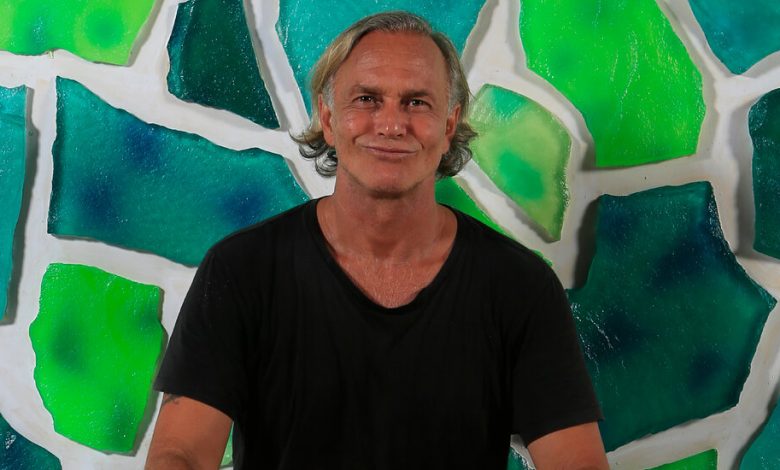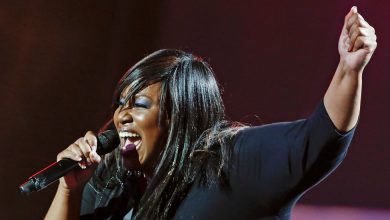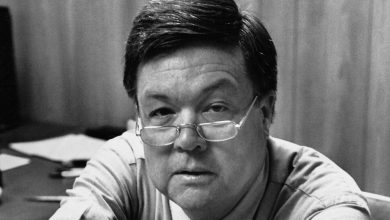Ashley Bickerton, Unflinchingly Honest About His Work and Illness

“I can’t think of another artist who was both brilliant on canvas and on a surfboard,” said Paul Theroux, the writer. He was speaking of one of the artists he most admired, Ashley Bickerton, and these words of Theroux’s inspired me to plan a trip to his home: “If Gauguin had caught some waves in Tahiti then I think we’d have an apt comparison.”
Ashley rose to prominence in the mid-1980s with ironic, abstracted constructions focused on ideas of consumerism, identity and value. He had been diagnosed with ALS in 2021, and by July, when I finally visited him in Bali, he needed help bringing food to his mouth, and he could no longer paint. But there was not an ounce of self-pity. “I consider myself enormously lucky,” said the artist from his power wheelchair. “It’s an incredible luxury that I can sit here on my big veranda on the hill overlooking the Indian Ocean, spend time with my wife and daughter, work on my computer, think, dream and put my life in order.”
He was courageous, graceful, eloquent, inspired. And full of gallows humor. After a Thai feast at his sprawling compound on the southern tip of Bali, I gestured toward his wife and three-year-old daughter, who were playing on the sofa, his paintings and sculptures surrounding us, his swimming pool and spectacular ocean view, and said, “What a beautiful life you’ve made for yourself.” With a rosy-cheeked grin he said, “What’s left of it.”
Ashley died on Nov. 30. He was 63.
I had come to interview him as an adjunct to his getting his affairs in order. We’d meet in the early afternoon in his crow’s nest of an office. Seated at his desk, often sipping a Coke through a straw, he’d excitedly show me the fantasy waves he’d been building in Photoshop (a devout surfer, ALS had robbed him of his daily fix). From there we’d move on to weightier stuff — his biography, his body of work, his family. He did not want to get into the details of his diagnosis. His face lit up when he spoke about the paintings he was making for his forthcoming exhibition in New York.
“I had two big shows in New York earlier this year,” he told me. “My whole plan had been to throw everything I had into these, then come back here and quietly rot away and die on my hill. Then Larry Gagosian stepped into the picture and ruined all my plans.”
He was referring to his recent good news. Gagosian had picked him up, scheduling his first solo show with the gallery in 2023. The announcement created buzz in the art world: “Over the past few years, Bickerton has brought his practice full circle, synthesizing its heterogeneous modes and gestures into an all-encompassing visual language.”
“It was exhilarating and much welcomed,” said Ashley. “But I suddenly realized that I’m going to be scrambling to the edge of the precipice without a moment to breathe.”
A Man of Two Worlds
Born in 1959 in Barbados to a clinical psychologist mother and a linguist father, Ashley’s childhood was itinerant, with stints in South America, the Caribbean, West Africa, England and eventually Hawaii, where he came to surfing at age 12. At the famed California Institute of the Arts, he studied with the conceptual artists Barbara Kruger and John Baldessari. “It was a real mind shake-up,” said Ashley. “I was basically told that everything I believed was rubbish, and that I should be ripping up bits of cardboard and locking myself in footlockers overnight and bending every rule.” He spent 12 years in New York, rising to fame in the 1980s alongside fellow Neo-Geo (for Neo-geometric conceptualism) artists Jeff Koons, Peter Halley and Meyer Vaisman.
The Fine Arts & Exhibits Special Section
- Bigger and Better: While the Covid-19 pandemic forced museums to close for months, cut staff and reduce expenses, several of them have nevertheless moved forward on ambitious renovations or new buildings.
- A Tribute to Black Artists: Four museums across the country are featuring exhibitions this fall that recognize the work of African and African American artists, signaling a change in attitude — and priorities.
- New and Old: In California, museums are celebrating and embracing Latino and Chicano art and artists. And the La Brea Tar Pits & Museum is working to engage visitors about the realities of climate change.
- A Cultural Correction: After removing all references to Columbus from its collections the Denver Art Museum has embraced a new exhibition on Latin American art.
- More From the Special Section: Museums, galleries and auction houses are opening their doors wider than ever to new artists, new concepts and new traditions.
Ashley’s early work drew from pop art, Op Art and minimalism. He became known for a mixed-media series titled as “Self-Portraits,” as “Commercial Pieces” or as “Anthropospheres,” composed of screen printed images of corporate logos. He even invented a brand for himself, SUSIE (full name: Susie Culturelux), which he said would double as an artistic signature for future art historians. In a clunky 1987-88 wall piece titled “Tormented Self-Portrait (Susie at Arles) #2” — there’s a version in the Museum of Modern Art’s collection — his Susie logo floats amid a sea of logos, among them Nike, Con Edison, Marlboro, Renault and Fruit of the Loom.
“My identity was forged in New York, my language, my sense of being an outsider,” said Ashley. “But New York never quite fit. I’m a tropics man. I was at odds with the Northeast winter.”
In 1993 he moved to Bali, where he resided until his death. Reading aloud from a manifesto he’d written some years back, he said, “Choose your material carefully. Avoid too many art fairs. And travel, limit your footprint and disappear.”
I first encountered Ashley via one of his self-portraits in Surfer’s Journal magazine in the late ’90s. Surrounded by palm trees, a near-naked woman, kids, dogs, tropical rapture, he was working bare-chested at an outdoor desk. He appeared robust, godlike. Like Gauguin in Tahiti or Peter Beard in Kenya, it was a portrait of an exotic, far-flung, fecund life. It made me wonder what the hell I was doing living in the East Village. When I told Ashley this in July, he chuckled.
“That was a sendup,” he said.
“What do you mean?” I asked.
“That was a request for a bio photo from Dakis Joannou’s DESTE Foundation [for Contemporary Art, a nonprofit]. I was gleefully, intentionally shoveling horseshit. But the photo got around, and people believed it. So I ran with it.”
Ashley’s work includes painting, photography, sculpture, assemblage and every combination therein. He melds beauty and grotesquerie, playfulness and brutality. “A friend said that when I’m serious I come off as joking, but when I’m joking I’m dead serious,” Ashley told me. “That play has been central to my work.”
His “Blue Man” series plops a blue-skinned tourist into clichéd tropical settings. “He’s an avatar for the archetype of the 20th century antihero escapee from the annals of the 20th century canon of literature,” explained Ashley. “But now he’s adrift in an alienating 21st century world, trying to live his Gauguin fantasy.”
I told him I thought it a bold move, living remotely, stepping away from “the conversation.”
“If you think of the art world as a marketplace, we artists are the suppliers,” Ashley said. “And if everyone’s farming the same soil, it creates a much more monocultural, homogeneous marketplace. But if you go further afield — both mentally and geographically — you can affect the psychology, you can bring back to market something of interest that’s harder to come by.”
In recent years his work took on oceanic themes, sometimes with a dystopian twist. In the “Ocean Chunk” series, originally dreamed up in New York shortly before his move to Bali, he uses resin and fiberglass to create the impression of water. He imagined these works as sensual material portals to faraway seas, calling them “a contemporary form of idolatry, a bulwark against longing.” Presiding above the table where we dined was a piece from his “Flotsam” series, a mixed-media painting made from trash washed up on a beach near his home.
He told me that younger artists had recently taken an interest in his work, and how that was a barometer more important to him than the marketplace.
“Ashley’s work has an abrasiveness and a vulnerability that I really appreciate,” said Jordan Wolfson, the multimedia artist known for challenging assumptions about gender, sexuality and the impact of technology.
“I loved Ashley for being a man of two worlds, navigating his way in the art hub and the remote island, between his studio and the great waves of Uluwatu,” said Theroux.
He continued, “I admired him as an artist, I related to him as a traveler and a reader, I loved him as a friend. Henry James’s line ‘Live all you can — it’s a mistake not to’ applies to Ashley. In life, in love, in marriages, in children — he had a huge appetite for living, and it shows in his work.”
Works That Defy Categorization
Ashley was already established when Damien Hirst, then an art student at Goldsmiths in London, became a fan. They first met in New York in the late ’80s, and remained close friends to the very end. “I don’t think Ashley realized how much of a hero he was to me,” said Damien. “His work just blew my mind — it still does. It’s so ahead of its time. You can’t categorize it. There’s a huge sense of truth revealed, and then a kind of emptiness where there’s no truth, and it just keeps going on and on. He’s always kind of revealing something and obscuring it at the same time.”
Conversations with Ashley often veered into humor. “I need levity. If you ask me my politics I wouldn’t say Democrat, I’d say George Carlin.” As his caregiver fed him French fries he grinned and said, “The neocolonial lifestyle.” His speech was punctuated with tongue clicks and um-ahs. He fastidiously chose his words. Though wheelchair-bound, he exuded a soaring jolliness. His big, wry grin had a way of cradling you.
“I don’t have a Why me? or Oh, the injustice of it all, that’s never even entered my head,” he told me. “There’s sort of a weird, detached bemusement, watching all this happening to me, like, Oh, how interesting. And then a continual need to improvise and tackle new setbacks in my physical condition.” He smile-frowned. “You just keep adapting to new indignities.”
He went on: “I’ve lost my legs completely. My hands are going soon. My voice and my ability to eat will fall off, that’s the natural course of the disease. But I’m happy in the moment. I’m much more sanguine about it all than I would expect to be at this stage.”
He knew that his work for the Gagosian show would be his last. He’d designed the paintings down to the last detail, handing the physical labor over to his assistant.
On the last afternoon I spent with Ashley we made our way down to the studio, he in his wheelchair, his three-year-old daughter, Io, ridiculously cute in a pink tutu, chasing behind. In the studio, Ashley inspected one of the paintings from his new “Blur” series. It depicted a muted, distant shape of a face, with a pair of bright blue circles for eyes. “We’re getting so close,” he said to his assistant. “But let’s get it right. These paintings are forever.”
Io was gliding around the studio on her Razor-style scooter, giggling wildly. She pulled up alongside her father. Studying the painting together, Ashley said, “Tell us what we need to do, baby girl. We don’t know. We’re just grown-ups.”
Jamie Brisick is a writer in Los Angeles.




